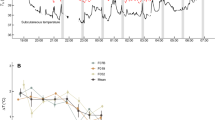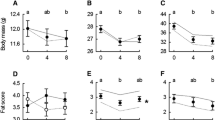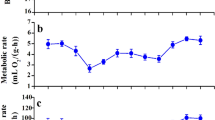Abstract
Knots Calidris canutus live highly seasonal lives, breeding solitarily on high arctic tundra and spending the non-breeding season in large social flocks in temperate to tropical estuaries. Their reproductive activities and physiological preparations for long flights are reflected in pronounced plumage and body mass changes, even in long-term captives of the islandica subspecies (breeding in north Greenland and northeast Canada and wintering in western Europe) studied in outdoor aviaries. The three to four fattening episodes in April-July in connection with the flights to and from the high arctic breeding grounds by free-living birds, are represented by a single period of high body mass, peaking between late May and early July in a sample of ten captive islandica knots studied over four years. There are consistent and synchronized annual variations in basal metabolic rate and thermal conductance in three islandica knots. Basal metabolic rate was highest during the summer body mass peak. Within the examined individuals, basal metabolic rate scales on body mass with an exponent of about 1.4, probably reflecting a general hypertrophy of metabolically expensive muscles and organs. Any potential effect of moult on basal metabolic rate was obscured by the large seasonal mass-associated variations. In breeding plumage, insulation (the inverse of thermal conductance) was a factor of 1.35 lower than in winter plumage. This was paralleled by the dry mass of contour feathers being a factor of 1.17 lower. In this subspecies the breeding season is indeed the period during which the costs of thermoregulation are lowest. In captive knots seasonal changes in basal metabolic rate and thermal conductance likely reflect an anticipatory programme adaptive to the variable demands made by the environment at different times of the year.
Similar content being viewed by others
Abbreviations
- bm:
-
body mass
- BMR:
-
basal metabolic rate
- MR:
-
metabolic rate(s)
- SMR:
-
standard metabolic rate(s)
- T a :
-
air temperature(s)
- T b :
-
body temperature
- TC:
-
thermal conductance
References
Adolph EF (1964) Perspective of adapatation: some general properties. In: Dill DB et al (eds) Handbook of physiology. Section 4: Adaptation to the environment. American Physiological Society, Washington, D.C., pp 27–35
Aschoff J (1981) Thermal conductance in mammals and birds: its dependence on body size and circadian phase. Comp Biochem Physiol 69A: 611–619
Aschoff J, Pohl H (1970) Der Ruheumsatz von Vögeln als Funktion der Tageszeit und der Körpergrösse. J Ornithol 111: 38–47
Barnett LB (1970) Seasonal changes in temperature acclimization of the house sparrow Passer domesticus. Comp Biochem Physiol 33: 559–578
Bartholomew GA (1982) Energy metabolism. In: Gordon MS (ed) Animal physiology: principles and adaptation. Macmillan, New York, pp 333–406
Berthold P (1975) Migration: control and metabolic physiology. In: Farner DS, King JR (eds) Avian biology, vol 5. Academic Press, New York, pp 77–124
Blem CR (1974) Geographic variation of thermal conductance in the house sparrow Passer domesticus. Comp Biochem Physiol 47A: 101–108
Clark NA (1983) The ecology of dunlin (Calidris alpina L.) wintering on the Seven Estuary. Unpublished Ph.D. thesis, Univ. of Edinburgh
Cramp S, Simmons KEL (eds) (1983) The birds of the Western Palearctic, vol. 3. Oxford University Press, Oxford
Daan S, Masman D, Strijkstra A, Verhulst S (1989) Intraspecific allometry of basal metabolic rate: relations with body size, temperature, composition, and circadian phase in the kestrel, Falco tinnunculus. J Biol Rhythms 4: 267–283
Daan S, Masman D, Groenewold A (1990) Avian basal metabolic rates: their association with body composition and energy expenditure in nature. Am J Physiol 259: R333-R340
Daan D, Masman D, Strijkstra A, Kenagy GJ (1991) Daily energy turnover during reproduction in birds and mammals: its relationships to basal metabolic rate. Acta XX Cong Internat Ornithol (Christchurch): 1976–1987
Dawson WR, Carey C (1976) Seasonal acclimization to temperature in cardueline finches. I. Insulative and metabolic adjustments. J Comp Physiol 112: 317–333
Dawson WR, Marsh RL, Yacoe ME (1983) Metabolic adjustments of small passerine birds for migration and cold. Am J Physiol 245: R755-R767
Davidson NC, Wilson JR (1992) The migration system of European-wintering knots Calidris canutus islandica. Wader Study Group Bull 64 [Suppl]: 39–51
Dietz M, Daan S, Masman D (1992) Energy requirements for molt in the kestrel Falco tinnunculus. Physiol Zool 65: 1217–1235
Dill DB, Adolph EF, Wilber CG (eds) (1964) Handbook of physiology. Section 4: Adaptation to the environment. American Physiological Society, Washington, DC.
Dol'nik VR, Gavrilov VM (1979) Bioenergetics of molt in the chaffinch (Fringilla coelebs). Auk 96: 253–264
Drent RH, Stonchouse B (1971) Thermoregulatory responses of the Peruvian penguin, Spheniscus humboldti. Comp Biochem Physiol 40: 689–710
Drent RH, Daan S (1980) The prudent parent: energetic adjustments in avian breeding. Ardea 68: 225–252
Drent R, Piersma T (1990) An exploration of the energetics of leap-frog migration in arctic breeding waders. In: Gwinner E (ed) Bird migration: physiology and ecophysiology, Springer, Berlin, pp 399–412
Gessaman JA (1987) Energetics. In: Giron Pendleton GA et al (eds) Raptor management techniques manual. National Wildlife Federation, Washington, D.C., pp 289–320
Gessaman JA, Nagy KA (1988) Energy metabolism: errors in gasexchange conversion factors. Physiol Zool 61: 507–513
Goede AA (1993) Variation in the energy intake of captive oystercatchers Haematopus ostralegus. Ardea 81: 89–97
Gwinner E (1986a) Circannual rhythms in the control of avian migrations. Adv Study Behav 16: 191–228
Gwinner E (1986b) Circannual rhythms: endogenous annual clocks in the organization of seasonal processes. Springer, Berlin
Hammond KA, Diamond J (1992) An experimental test for a ceiling on sustained metabolic rate in lactating mice. Physiol Zool 65: 952–977
Hart JS (1964) Insulative and metabolic adaptations to cold in vertebrates. Symp Soc Exp Biol 18: 31–48
Herreid CF II, Kessel B (1967) Thermal conductance in birds and mammals. Comp Biochem Physiol 21: 405–414
Heusner AA (1984) Biological similittude: statistical and functional relationships in comparative physiology. Am J Physiol 246: R839-R845
Hill RN (1972) Determination of oxygen consumption by use of the paramagnetic oxygen analyzer. J Appl Physiol 33: 261–263
Hohtola E, Hissa R, Imppola, Pönni J, Saarela S (1991) Cold thermogenesis in the summer and winter-acclimatized pheasants and partridges. Suomen Riista 37: 18–26
Jenni-Eiermann S, Jenni L (1991) Metabolic responses to flight and fasting in night-migration passerines. J Comp Physiol B 161: 465–474
Kendeigh SC (1949) Effect of temperature and season on energy resources of the English sparrow. Auk 66: 113–127
Kendeigh SC, Blem CR (1974) Metabolic adaptation to local climate in birds. Comp Biochem Physiol 48A: 175–187
Kersten M, Piersma T (1987) High levels of energy exeenditure in shoerebierds; metabolic adaptations to an energetically expensive way of life. Adrea 75: 175–187
Lasiewski RC, Dawson WR (1967) A re-examination of the relation between standard metabolic rate and body weight in birds. Condor 69: 13–23
Lindström Å, Visser GH, Daan S (1993) The energetic cost of feather synthesis is proportional to basal metabolic rate. Physiol Zool 66: 490–510
Marsh RL, Dawson WR (1989) Avian adjustments to cold. In: Wang LCH (ed) Advances in comparative and environmental physiology, vol 4. Springer, Berlin, pp 205–253
Masman D, Dijkstra C, Daan S, Bult A (1989) Energetic limitation of avian parental effort: field experiments in the kestrel (Falco tinnunculus). J Evol Biol 2: 435–455
McNab BK (1980) On estimating thermal conductance in endotherms. Physiol Zool 53: 145–156
Meier AH, Fivizzani AJ (1980) Physiology of migration. In: Gauthreaux SA Jr (ed) Animal migeration, orientation and navigation. Academic Press, New York, pp 225–283
Nettleship DN (1974) The breeding of the knot Calidris canutus at Hazen Camp, Ellesmere Island, N.W.T.. Polarforschung 44: 8–26
Peterson CC, Nagy KA, Diamond JA (1990) Sustained metabolic scope. Proc Natl Acad Sci USA 87: 2324–2328
Pienkowski MW, Lloyd CS, Minton CDT (1979) Seasonal and migrational weight changes in dunlins. Bird Study 26: 134–148
Piersma T, Davidson NC (1992) The migrations and annual cycles of five subspecies of knots in perspective. Wader Study Group Bull 64 [Supp]: 187–197
Piersma T, Drent R, Wiersma P (1991a) Temperate versus tropical wintering in the world's northernmost breeder, the knot: metabolic scope and resource levels restrict subspecific options. Acta XX Congr Internat Ornithol (Christchurch): 761–772
Piersma T, Tulp I, Verkuil Y, Wiersma P, Gudmundsson GA, Lindström Å (1991b) Arctic sounds on temperate shores: the occurrence of song and ground display in knots Calidris canutus at spring staging sites. Ornis Scand 22: 404–407
Piersma T, Prokosch P, Bredin D (1992) The migration system of Afro-Siberian knots Calidris canutus canutus. Wader Study Group Bull 64, [Suppl]: 52–63
Piersma T, Hoekstra R, Dekinga A, Koolhaas A, Wolf P, Battley P, Wiersma P (1993a) Scale and intensity of intertidal habitat use by knots Calidris canutus in the western Wadden Sea in relation to food, friends and foes. Neth J Sea Res 31: 331–357
Piersma T, Koolhaas A, Dekinga A (1993b) Interactions between stomach structure and diet choice in shorebirds. Auk 110: 552–564
Piersma, T, van der Meer J, Drent R (1994a) Seasonal shifts in body composition of a long-distance migrant, the knot: a function of food type and work level? In: Piersma T (ed) Close to the edge: energetic bottlenecks and the evolution of migratory pathways in knots. Ph.D. Thesis, University of Groningen, The Netherlands, pp 262–272
Piersma T, Wiersma P, Bruinzeel L, Kersten M, Drent R (1994b) intraspecific variability in basal metabolic rates of Calidris sandpipers reflect maintenance costs of a flexible metabolic machinery. In: Piersma T (ed) Close to the edge: energetic bottlenecks and the evolution of migratory pathways in knots. Ph.D. Thesis, University of Groningen, The Netherlands, pp 273–279
Pohl H (1971) Seasonal variation in metabolic functions of bramblings. Ibis 113: 185–193
Porter WP (1969) Thermal radiation in metabolic chambers. Science 166: 115–117
Prinzinger R (1982) The energy cost of thermoregulation in birds: the influence of quick sinusoidal temperature fluctuations on the gaseous metabolism of the japanese quail. Comp Biochem Physiol 71A: 469–472
Rintamäki H, Saarela S, Marjakangas A, Hissa R (1983) Summer and winter temperature regulation in the black grouse Lyrurus tetrix. Physiol Zool 56: 152–159
Schmidt-Nielsen K (1975) Animal physiology: adaptation and environment. Cambridge University Press, Cambridge
Scholander PF, Hock R, Walters V, Johnson F, Irving L (1950a) Heat regulation in some arctic and tropical mammals and birds. Biol Bull 99: 237–258
Scholander PF, Hock R, Walters V, Irving L (1950b) Adaptation to cold in arctic and tropical mammals and birds in relation to body temperature, insulation, and basal metabolic rate. Biol Bull 99: 259–271
Scholander PF, Walters V, Hock R, Irving L (1950c) Body insulation of some arctic and tropical mammals and birds. Biol Bull 99: 225–236
Steen J (1958) Climatic adaptations in some small northern birds. Ecology 39: 625–629
Wallgren H (1954) Energy metabolism of two species of the genus Emberiza as correlated with distributions and migration. Acta Zool Fennica 84: 1–110
Weathers WW, Caccamise DF (1978) Seasonal acclimatization to temperature in monk parakeets. Oecologia 35: 173–183
Weiner J (1992) Physiological limits to sustainable energy budgets in birds and mammals: ecological implications. Trends Ecol Evol 7: 384–388
Wiersma P, Piersma T (1994) Effects of microhabitat, flocking, climate and migratory goal on energy expenditure in the annual cycle of red knots. Condor 96: 257–279
Wilkinson L (1990) SYSTAT: the system for statistics. SYSTAT, Evanston, IL, USA
Wijnandts H (1984) Ecological energetics of the long-eared owl (Asio otus). Ardea 72: 1–92
Author information
Authors and Affiliations
Additional information
Communicated by H. Langer
Rights and permissions
About this article
Cite this article
Piersma, T., Cadée, N. & Daan, S. Seasonality in basal metabolic rate and thermal conductance in a long-distance migrant shorebird, the knot (Calidris canutus). J Comp Physiol B 165, 37–45 (1995). https://doi.org/10.1007/BF00264684
Accepted:
Issue Date:
DOI: https://doi.org/10.1007/BF00264684




